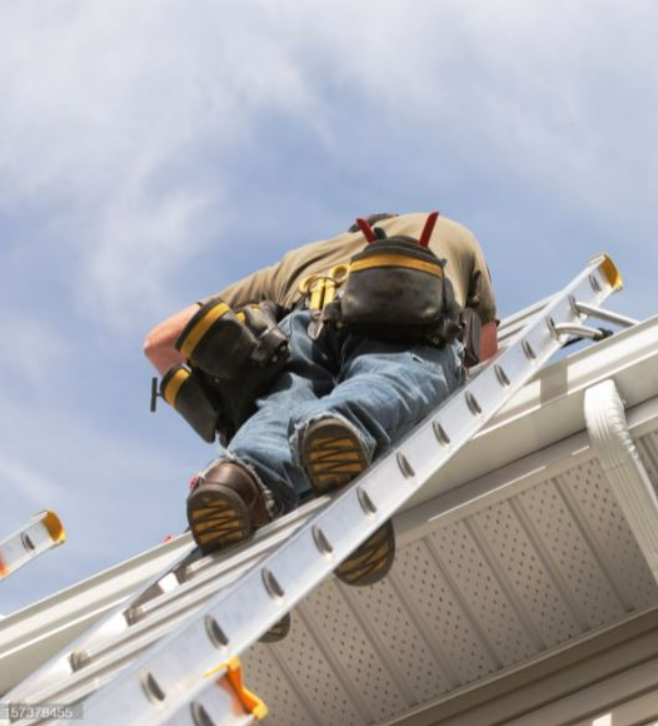eNews: Volume 20, Number 11 (March 2023)
Volume 20, Number 11 (March 2023)
From the Director’s Desk
John Howard, M.D. Director, NIOSH
Get a Grip on Fall Prevention and Ladder Safety
The construction industry has many safety and health hazards, with falls from heights take the greatest toll. Each day in the United States, one construction worker on average dies in a fall from heights. Many of these fatalities occur when workers fall from roofs, ladders, and scaffolds. Construction companies with less than 20 employees and Hispanic workers are at the greatest risk.
Fatalities and injuries from falls place an emotional, medical, and financial burden on workers, coworkers, families, and communities. However, falls can be prevented with proper work practices, equipment, training, and planning. The Center for Construction Research and Training (CPWR) recently surveyed people who experienced, witnessed, or investigated a workplace fall and found lack of planning to be a key underlying cause.
In March, we will observe National Ladder Safety Month. In addition to the toll falls from ladders take on construction workers, over 300 people at home and at work die in ladder-related accidents, and 500,000 are treated for ladder-related injuries each year. Many of these accidents are preventable by following these tips:
- Use ladders only when necessary
- Get properly trained in ladder safety
- Choose the right ladder for the job
- Keep the ladder on level ground
- Inspect ladders regularly
- Avoid ladder overload
This event aims to raise awareness of ladder safety at home and in all workplaces to decrease the number of ladder-related injuries and fatalities.
Another safety event, the National Campaign to Prevent Falls in Construction, takes place May 1–5. NIOSH and partners invite all construction workplaces, regardless of size, to participate and host a safety stand-down. A stand-down is a chance for employers and employees to talk about training, job hazards, protective methods, reporting unsafe conditions, and the company’s safety policies, goals, and expectations. Your involvement can be as simple as sharing some of our fall prevention resources at your worksite.
Please join me in recognizing these important safety observances. When working at heights, the risk of falling is always present—but falls can be prevented by making fall prevention a habit.
Injuries That Happen at Work Lead to More Opioid Prescriptions and Higher Opioid Costs
NIOSH study authors: Abay Asfaw, Brian Quay, Tim Bushnell, and Regina Pana-Cryan
What did the study find?
Compared to other injury-related health conditions, work-related injuries accounted for more opioid prescriptions from 2010 to 2019. In this period, nearly 28% of all opioid prescriptions were for work-related injuries, although only 22% of reported injuries among adults were work-related. After accounting for other factors, we found that work-related injuries increased the chances of opioid prescriptions by one third.
In other findings, work-related injuries accounted for 37% of the total number of days that opioids were prescribed and for nearly 40% of the total opioid cost. In addition, compared to other injuries, work-related injuries were associated with opioid prescriptions that were 6 days longer and cost $29 more per year, on average.
Why is the study important?
As the opioid overdose epidemic continues, prescription opioid-related death rates are rising, according to CDC. At the same time, little is known about the relationship between work-related injuries and the opioid crisis or about how patterns of opioid prescriptions in the work environment may differ from patterns of opioid prescriptions in other environments.
How did you do the study?
Using a nationwide survey called the Medical Expenditure Panel Survey, we compared opioid prescriptions for work-related and other injuries from 2010 to 2019. The survey includes detailed information about injuries, illnesses, treatments, and costs, as well as demographics such as education, health, working status, income, and insurance coverage.
What are the next steps?
Safety promotion and injury prevention in the workplace are critical. Our findings highlight the need for making workplaces safer and for supporting recovery from work-related injuries and opioid use disorders. The findings also show the need for alternative approaches to treating pain resulting from work-related injuries.
Results of the 2019 Survey of Engineered Nanomaterial Occupational Health and Safety Practices
Study authors: Nicole M. Neu-Baker, State University of New York Polytechnic Institute; Adrienne Eastlake and Laura Hodson, NIOSH
Why is this study important?
Engineered nanomaterials are tiny—smaller than a human hair—artificially produced materials. Increasingly, they are used in a variety of materials, including electronics, medicines, and clothing, yet we still are learning about their potential health effects.
Since establishing the Nanotechnology Research Center (NTRC) in 2004, NIOSH has led nationwide research efforts related to the safe use of engineered nanomaterials in the workplace. Part of this effort involves providing written health and safety recommendations to workers who handle engineered nanomaterials. This study aimed to understand whether workers follow these recommendations.
How did you do the study?
From September to December 2019, we worked with RTI International to administer an online survey about workplace safety and health practices related to nanomaterials. Forty-five U.S. and Canadian companies completed the survey developed by RAND Corporation.
What did you find?
Nearly a third of the companies reported monitoring the workplace environment. While 89% had special cabinets that prevented contaminants from reaching a workspace, only 68% required them for working with nanomaterials.
Most of the companies reported providing safety and health information and training. Less than a third said they provided health monitoring specifically for workers who handled nanomaterials. The companies described widespread use of personal protective equipment, with all reportedly using gloves and nearly all using eye and face protection.
In terms of NIOSH resources, more than a third of companies reported they used at least one resource about safely handling nanomaterials.
What are the next steps?
These results provide important information about the NIOSH NTRC’s influence on nanomaterial health and safety in the workplace that can be used to develop additional outreach materials, especially for small businesses.

Photo by ©Getty images
Director’s Desk
Research Rounds
- Injuries That Happen at Work Lead to More Opioid Prescriptions and Higher Opioid Costs
- Results of the 2019 Survey of Engineered Nanomaterial Occupational Health and Safety Practices
Highlights
- In Memoriam: Jessica Elzea Kogel, PhD
- Retirement of Frank Hearl, NIOSH Chief of Staff
- Call for Papers: Addressing the Current Health Worker Mental Health Crisis
- Register Now and Submit Posters for the Toxicology and Risk Assessment Conference
- Register Now for the Next NIOSH Expanding Research Partnerships Webinar!
- Phase 1 Winners of NIOSH Counterfeit N95 Challenge Announced
- Watch Highlights From the 3rd International Symposium to Advance TWH
Monthly Features
John Howard, M.D., Director
Christina Spring, Editor in Chief
Managing Editor
Tanya Headley
Section Editor
Anne Blank, Research Rounds
Kiana Harper, Highlights & Monthly Features
Contributing Editors
Sarah Mitchell
Copy Editor
Cheryl Hamilton
Technical Support
Steve Leonard, Technical Lead
Sabrina Nur, Web Developer
To receive the NIOSH eNews email newsletter, enter your email address:

Photo courtesy of Dr. Kogel's family
In Memoriam: Jessica Elzea Kogel, PhD
With profound sadness, we announce the death of former CDC employee Jessica Elzea Kogel, PhD. Dr. Kogel served as the NIOSH Associate Director for Mining from 2016 until she retired on December 31, 2022. Her retirement capped a 6-year career leading the NIOSH Mining Program through a period of innovative refocusing and continued mining health and safety accomplishments. Dr. Kogel earned her bachelor’s degrees in Earth Science and Paleontology from the University of California at Berkeley. She went on to Indiana University Bloomington where she earned a master’s degree and PhD in Geology. After graduating, she worked in private industry for 25 years. She held numerous patents, coauthored many peer-reviewed publications, and authored two books. Open to new experiences, places, and people, and with a thirst for living life to its fullest, she embraced new opportunities for exploration. However, her first priority was her family, and she loved nothing more than spending time with them hiking local trails, enjoying board games, harvesting homegrown vegetables, and preparing meals with everyone gathered around the table. Jessica’s family intends to hold a memorial service for her this summer.

Photo by NIOSH
Retirement of Frank Hearl, NIOSH Chief of Staff
On December 31, 2022, NIOSH Chief of Staff Frank Hearl retired from federal service after serving 48 years with NIOSH. Frank served as the NIOSH Chief of Staff since 2005. During his time at NIOSH, he worked as a Branch Chief and later Deputy Director in the Division of Respiratory Disease Studies in Morgantown, West Virginia. His work at NIOSH included quality assurance engineering, field industrial hygiene, occupational epidemiology, and research management. Frank coauthored numerous publications on industrial hygiene, exposure assessment, silicosis, coal workers pneumoconiosis, cumulative risk, occupational robotics, and artificial intelligence. We are grateful for the significant impact Frank made toward the health and well-being of workers. Maria Strickland is serving as Acting Chief of Staff until a permanent replacement is found.
Call for Papers: Addressing the Current Health Worker Mental Health Crisis
NIOSH and the American Journal of Public Health are seeking manuscripts for an upcoming supplement exploring effective approaches for addressing the current health worker mental health crisis and building a sustainable future. Manuscripts should update current knowledge and summarize research needs on effective approaches and solutions for improving workplace mental health within the health workforce. Submit online by May 15, read author guidelines, or contact Tom Cunningham for more information.
Register Now and Submit Posters for the Toxicology and Risk Assessment Conference
Registration for the 2023 Toxicology and Risk Assessment Conference (TRAC), April 24-27 is now open! The 4-day meeting, cosponsored by NIOSH, will focus on toxicology topics and risk assessment principles and practice. If you submitted a poster abstract to another relevant conference last year, you are encouraged to submit that abstract to TRAC to stimulate discussion in TRAC’s more focused environment. Email your poster abstract submissions to TRAC today!
Register Now for the Next NIOSH Expanding Research Partnerships Webinar!
On March 8, from 11:00 a.m.—12:30 p.m. (ET), NIOSH will host the next Expanding Research Partnerships Series webinar, “Operationalizing Ex4OSH research paradigm.” Featured speakers will explore using collaboration to address key challenges to occupational safety and health research, training, and practice. Read more and register.
Phase 1 Winners of NIOSH Counterfeit N95 Challenge Announced
The Phase 1 winners of the NIOSH Counterfeit N95 challenger were just announced! The COVID-19 global pandemic unleashed a flood of counterfeit respirators into the marketplace, especially N95 filtering facepiece respirators. As a result, NIOSH sought help finding improved tools to identify counterfeits as well as new approaches and technologies to help educate vendors and users about counterfeit respirators. NIOSH partnered with NASA and HeroX to launch this competition. Learn more at https://www.herox.com/NIOSHCounterfeitN95/update/5370.
Watch Highlights From the 3rd International Symposium to Advance TWH
You can now watch recordings from the 2022 symposium to Advance Total Worker Health (TWH). View the opening ceremonies, keynote presentations, closing remarks, and award ceremonies. Don’t forget to search #TWHSymposium on social media for ongoing updates from the event.
New Communication Products & Reports
FACE Reports
- Farm Worker’s Hand Mangled in Hop Harvester—Washington (slide show)
- Driver Crushed by Rollaway Woodchip Truck—Washington
- Kentucky Occupational Health Indicators Report
- Tree Worker Electrocuted From Power Lines while Trimming Trees—Massachusetts
Fire Fighter Fatality Investigation and Prevention Program Reports
- 40-Year-Old Firefighter Dies while Driving a Water Tender to a Fire—Michigan
- Fire Service Community Meeting Summary: Fire Service Suggestions and NIOSH Responses
- Fire Fighter Fatality Investigation and Prevention Program Prioritization Guidelines—2022
Video
Workplace Solutions
NIOSH Science Blog
Sign up to have notifications about new NIOSH Science Blogs delivered directly to your inbox! Here are the blogs from last month:
- The Effectiveness of DIY Air Filtration Units
- Violence Against Public Health Workers
- Highly Pathogenic Avian Influenza (HPAI) in the Agricultural Community
- Psychosocial Hazards Often Overlooked in Construction Industry
- Work as a Key Social Determinant of Health: The Case for Including Work in All Health Data Collections
- The State of Health Surveillance Across the Public Safety Sector
- Modern Coal Miners Have Higher Death Rates From Lung Diseases Than Their Predecessors
Federal Register Notices
Advisory Board on Radiation and Worker Health, National Institute for Occupational Safety and Health
The notice was posted on February 13. Comments must be received by March 2. The meeting will be held on March 9.
Proposed Data Collection Submitted for Public Comment and Recommendations: Pre-Shift Lighting Interventions to Improve Miner Safety and Well-being
The notice was posted on January 18. Comments must be received by March 20.
NORA
Upcoming Sector Council Meeting
The NORA Construction Sector Council is having their virtual only Spring/Summer meeting on May 23. Don’t miss out! If you’re interested in joining, please email the Sector Coordinator.
News from Our Partners
Did You Know?
OSHA has resources to keep tree care and landscaping workers safe from falls, electrocution, struck-by, caught-in, and other hazards. See also the Solutions for Tree Care Hazards infographic.
Learn More About the WVU Online Population Health MS Program
The West Virginia University (WVU) School of Public Health is hosting two informational sessions about its online MS in Population Health. One session will be in-person on the WVU Health Sciences Campus on March 2, and the other will be via Zoom on March 7. This is one of only seven programs of its kind in the country being offered by a CEPH-accredited school, and recently earned certification in population health management by the Commission on Accreditation of Healthcare Management Education. Find out more!
Violence & Aggression in Health Care
New research from the New Hampshire (NH) Occupational Health Surveillance Program, in collaboration with the NH Healthcare Violence Prevention Group, spotlights the incidence and consequences of violent events in NH hospitals. Over 200 staff from six NH emergency departments responded to the survey, conducted in 2022. Despite the challenges, the research noted a range of solutions, including updates to facilities and personnel, as well as improving hospital and state policies around the preparation, reporting, and follow-up of violent events.
Call for Manuscripts:
- Special Issue of Healthcare titled “What Did the COVID-19 Pandemic Teach Us About Health Literacy and Health Communication?”: The deadline to submit manuscripts is March 31.
Call for Proposals:
Conferences, Meetings, Webinars, & Events
This page provides a list of publicly available occupational safety and health-related conferences, meetings, webinars, and events sponsored by NIOSH as well as other government agencies, and nongovernment agencies, such as universities, professional societies, and organizations.
